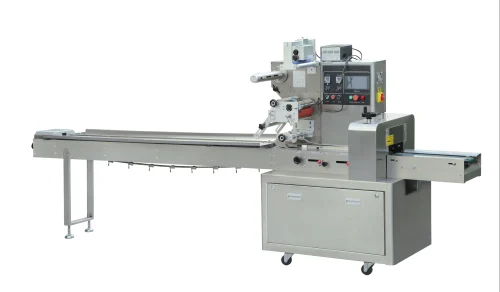Meaning of DZB Flow Wrapping Machine
DZB Flow Wrapping Machines are a type of form-fill-seal (FFS) machine that operates horizontally compared to vertical form-fill-seal machines, which work in the perpendicular direction. For this reason, they are more suitable for flat products and low-profile items.
How does it work?
DZB Flow Wrapping Machine packaging is a precise coordination of various components;
Film Feeding: The film roll is unraveled and passed through the mechanisms of the machine. Film speed and tension are regulated for smooth feeding.
Product Loading: In some cases, depending on how the machine is set up, products can be added manually or automatically onto the film. Most times in automatic systems, products are fed into the machine using a conveyor belt or feeder mechanism.
Film Forming and Sealing: Plastic forming boxes or adjustable guides shape the film around the product. Then heat sealing devices seal the edges of the film forming an air-tight package. This type of sealing may involve hot sealing, cold sealing, or ultrasonic sealing depending on the packaging material used and product requirements.
Cutting: After that sealing is done using a cutting blade or device that separates them from a continuous roll of films. Precision cutting enhances neat edges and uniform packing.
Product Discharge: From there packaged goods leave either to be transferred to another processing stage using a conveyor belt or directly into their final package such as a carton box.
Components and Features
Every component in a DZB Flow Wrapping Machine contributes significantly to its efficient functionality:
Film Roll Holder: This part situated at most times in the beginning holds firmly onto the roll containing packing material ensuring unwinding is smooth always.
Forming Box: With variation in size and shape this component helps us create pouches out of films wrapping around commodities within.
Sealing Mechanism: Heat seal bars/ rollers pressurize with heat upon film edges thus creating tightly sealed packs. For instance, temperature and pressure can be changed to adjust seal strength optimally.
Cutting Blade: There is a sharp knife or cutting mechanism that separates packed goods from a roll of film in a clean manner. Some machines come with zigzag/serrated blades to allow easy opening of packs.
Control Panel: Operators can input parameters such as packaging speed, tension on the films, and sealing temperature via a user-friendly interface. Touchscreen displays and programmable features may form part of some advanced models.
Adjustable Speed and Film Tension: These help fine-tune the packing process for different product types and materials used in packing.
Product Detection System: To ensure accurate alignment and packaging cameras or sensors detect the presence and position of products on film during DZB Flow Wrapping.
DZB Flow Wrapping Products
The applications that are done using the DZB flow wrap machine include the following:
Bakery items such as breads, buns, cookies, pastries
Confectionery like chocolates, candies, chewing gum snack bars, etc
Fresh produce for example fruits, vegetables, salads herbs, etc
Pharmaceutical products like tablets capsules syringes medical devices etc
Stationeries pens pencils erasers notebooks etc
Household goods soap bars sponges cleaning wipes etc
DZB Flow Wrapping Machines have been improved over the years to meet the changing needs of various industries since they were introduced. While initially meant for food packaging, they have now found their way into the pharmaceutical industry, as well as cosmetics, and consumer goods manufacturing. They are indispensable in modern production facilities because of their ability to work with different kinds of shapes of products, sizes, and materials used for packaging.
Advantages
Manufacturers have a lot to gain from adopting DZB Flow Wrapping Machines:
Increased Efficiency: Automation helps reduce manual labor and improve the packaging process such that it can generate more timely outputs.
Enhanced Product Protection: Packaging that is secure and tamper-evident can help preserve quality and freshness while extending shelf life.
Versatility: There is minimal alteration when packing different types of items that come in varying sizes due to flexible design.
Cost-Effectiveness: Overall savings on packaging costs result from optimized material use and reduced workforce expenses.
Hygienic Packaging: For food processing facilities, pharmaceuticals, or medical applications these packages must be sealed to shield the contents from impurities thus maintaining hygiene standards.
Factors to Consider When Choosing
The following are some factors that one has to take into account when selecting an appropriate DZB Flow Wrapping Machine:
Production Capacity: The machine should match the speed and throughput requirements for your line of production.
Product Specifications: Make sure your product size, shape, and weight are not compromised by using this machine if you want good-quality packing.
Packaging Material Compatibility: select a machine based on your product’s packaging material whether it’s polyethylene (PE), polypropylene (PP), laminates, or biodegradable films.
Space and Layout: To choose a flow wrapping machine with the right configuration and size you need to assess available space within your plant as well as the layout of your packaging line.
Budget and ROI: If you decide to buy a DZB Flow Wrapping Machine, you have to consider how much it costs initially, its upkeep cost, and whether it will bring returns in due time.
Future Trends and Innovations
There are several emerging trends and innovations that will shape the future of DZB Flow Wrapping Machines;
Integration of IoT and Industry 4.0: By using Internet of Things (IoT) technology, packaging processes can be optimized through remote control, predictive maintenance, and data analysis.
Sustainable Packaging Solutions: Environmental concerns are driving the development of eco-friendly packaging materials as well as efforts to recycle them.
Robotics and Automation: Through continuous integration, robotics and automation improve the flexibility, speed, and accuracy of machines thus making them fit into smart manufacturing systems seamlessly.
Customization and Personalization: To meet the consumers’ needs for individualized products as well as packing options; manufacturers must develop machines with on-demand customization ability incorporating variable data printing.

